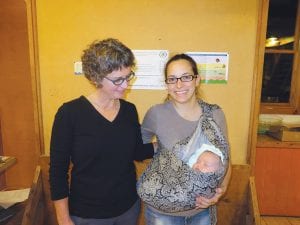Minnesota Department of Health Research Scientist Patricia McCann visits with Monica Anderson while looking adoringly at baby Edith. Monica and Edith attended the Fish are Important for Superior Health (FISH) update at North House Folk School on November 17 where McCann gave the results of the year long study involving 499 Cook County women.

“We know that too much mercury in a developing fetus or young child can affect a child’s I.Q., their ability to learn and to process information,” said Minnesota Department of Health Research Scientist Patricia McCann, who headed up the Cook County Fish are Important for Superior Health (FISH) Project.
With canoes and boats overhead in the rafters and Lake Superior’s waves lapping gently on the shore just outside, North House Folk School was the perfect place to present the first (of potentially many) findings from the FISH report.
McCann addressed a roomful of mostly women on Tuesday, November 17 and presented the results of the study conducted from May 2014 to June 2015. Some 499 women, ages 16 to 50 that live in or near Cook County, took part in the study and only 3 percent of them were over the safe level of mercury, she said.
“We had a broad spectrum of people,” McCann said. “Everyone from vegetarians to women who ate fish almost every day.”
Why did the state pick Cook County for its study? McCann said an earlier research report showed 10 percent of Minnesota babies tested in the North Shore area had unsafe levels of mercury in their blood, and those results triggered the need for analysis.
Participants reported eating over 40,000 meals of fish during the study, with 28 percent of those fish caught locally. About 70 percent ate canned tuna, walleye, salmon, lake trout, and shellfish while 80 percent said they ate fish caught locally. Most of those meals were made up of lake trout, walleye, herring, and whitefish. McCann said 4 percent of participants didn’t eat any fish.
“All fish contains at least a small amount of mercury,” she said.
“People shed mercury through their hair, fingernails and through their excrement. Adults can eat three times more fish than kids, but not everyone who ate more fish than recommended by the guidelines had a mercury level above recommended levels. This is because mercury is processed differently in different people.”
No two lakes have the same amount of mercury in them, even if they are next to one another, she said.
Mercury comes from a variety of sources, said McCann. “Mercury in Minnesota waters comes from coal combustion, mining, and worldwide emissions and other human activity.”
Once the mercury is in the water it is absorbed by algae, which is eaten by little minnows and fish. They in turn are eaten by bigger fish, which are caught and eaten by people.
Lakes in northern Minnesota have more mercury in them than lakes found in the metro area, said McCann. Northern and walleye, which are top predators, have more mercury than less predatory fish.
And cutting fat from fish won’t reduce the level of mercury in them, said McCann, explaining that mercury is stored in muscle.
Benefits of eating fish outweigh the risks
“We hope we don’t scare people away from eating fish,” said McCann. “I eat fish.” She said benefits of eating fish outweigh the risks if women follow the guidelines set forth by the state.
Fish provide many good nutrients, she said. They are low in bad fats and a good source of protein, iodine, and vitamin D. They are also high in DHA and EPA omega-3 fatty acids. These fatty acids, said McCann, are important for eye and brain development.
Among the 499 Cook County participants, 37 percent had DHA and EPA Omega-3 fatty acids at or above the national averages.
Through this study, said McCann, “We hope to help women and their families enjoy the health benefits of eating fish while lowering their exposure to mercury.”
Some women didn’t think eating tuna counted, but tuna is a fish, said McCann. Albacore tuna has more mercury than cheaper brands packed in water or oil because it is made from tuna that is more predatory than smaller tuna, she said.
As far as eating fish you catch in Minnesota, McCann said to use the Minnesota Department of Natural Resources (DNR) fish guidelines. Unless they are lake specific, the guidelines are general in nature, but should provide sound advice.
Although there are more than 10,000 lakes in the state, only 5,044 of them are fishable, she said. And of those lakes, the state has data on 1,800.
McCann thanked Sawtooth Mountain Clinic employees Joyce Klees and Theresa Borak for their work coordinating and interviewing the women who took part in FISH. Sawtooth Mountain Clinic Director Rita Plourde said she was happy the clinic could take part in helping the community, and she thanked her staff for all of their time in writing the grant and performing the necessary work to aid in making the study so successful.
More needs to be learned, said McCann, adding that FISH studies will be taking place on the South Shore of Lake Superior and in Illinois. Results from those projects will aid in this research, she said.
As far as the 3 percent of women who had high levels of mercury, they have been getting help from the clinic and will continue to be monitored.
Eat fish, said McCann, but follow the specific guidelines for individual lakes, or if they don’t exist, follow the Minnesota DNR guidelines that are more general.
After all, everyone wants to have a smart, happy, healthy baby, and eating the right amount of fish can be a big part of that.


Loading Comments